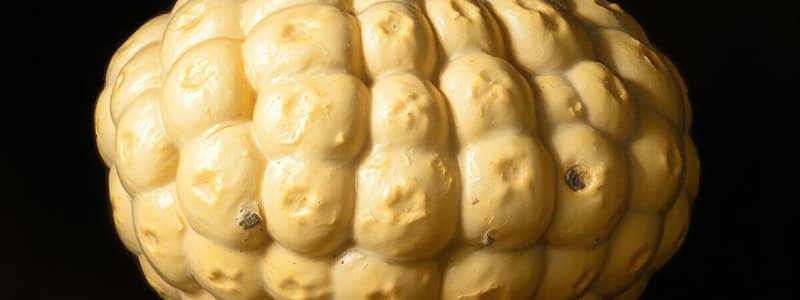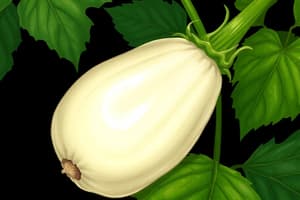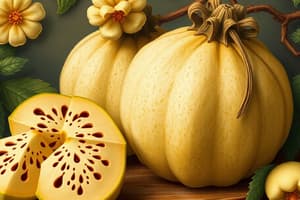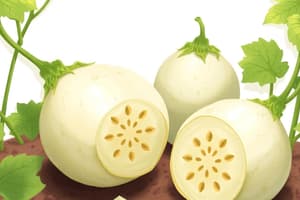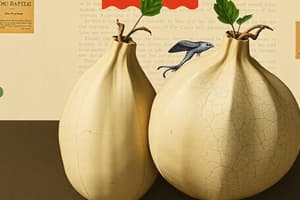Podcast
Questions and Answers
Which type of plant is jicama categorized as?
Which type of plant is jicama categorized as?
- Herbaceous vine (correct)
- Annual flower
- Woody shrub
- Deciduous tree
What characteristic defines jicama as a perennial plant?
What characteristic defines jicama as a perennial plant?
- It produces seeds every season.
- It lives longer than two years. (correct)
- It blooms flowers yearly.
- It requires replanting every year.
What is the first step in processing jicama for consumption?
What is the first step in processing jicama for consumption?
- Harvesting the tuberous root. (correct)
- Boiling to soften.
- Seasoning with spices.
- Cutting into slices.
In which regions of the world is jicama most widely grown and used?
In which regions of the world is jicama most widely grown and used?
What is the second step in preparing jicama after harvesting?
What is the second step in preparing jicama after harvesting?
What is the primary economic purpose for which Jatropha is grown?
What is the primary economic purpose for which Jatropha is grown?
Which part of the Jatropha plant is utilized for oil extraction?
Which part of the Jatropha plant is utilized for oil extraction?
During the processing of Jatropha seeds, what is the purpose of drying the seeds?
During the processing of Jatropha seeds, what is the purpose of drying the seeds?
Which method is NOT mentioned as a way to extract oil from crushed Jatropha seeds?
Which method is NOT mentioned as a way to extract oil from crushed Jatropha seeds?
What is the final step in the oil extraction process from Jatropha seeds?
What is the final step in the oil extraction process from Jatropha seeds?
What significant impact did the introduction of the potato to the British Isles have by 1800?
What significant impact did the introduction of the potato to the British Isles have by 1800?
Which factor contributed to the susceptibility of the potato crop to pests and pathogens?
Which factor contributed to the susceptibility of the potato crop to pests and pathogens?
What ecological condition is essential for the thriving of taro corm?
What ecological condition is essential for the thriving of taro corm?
What method is used for propagating yams?
What method is used for propagating yams?
Which of the following correctly describes a true root?
Which of the following correctly describes a true root?
What distinguishes bulbs from tubers in their structure?
What distinguishes bulbs from tubers in their structure?
Which of the following is NOT an example of a major root crop?
Which of the following is NOT an example of a major root crop?
What is the defining characteristic of taproots?
What is the defining characteristic of taproots?
Which family do onions belong to?
Which family do onions belong to?
What was one of the initial uses of spices in food?
What was one of the initial uses of spices in food?
Which group played a significant role in the spice distribution following the Crusades?
Which group played a significant role in the spice distribution following the Crusades?
What led to the sacking of Constantinople in 1204 during the Fourth Crusade?
What led to the sacking of Constantinople in 1204 during the Fourth Crusade?
What type of spices were primarily imported to Europe through the Spice Trade?
What type of spices were primarily imported to Europe through the Spice Trade?
What effect did Marco Polo's expeditions have on Europe regarding spices?
What effect did Marco Polo's expeditions have on Europe regarding spices?
What was one of the primary reasons the overland caravan trade routes became dangerous?
What was one of the primary reasons the overland caravan trade routes became dangerous?
Which country initially monopolized the trade in black pepper and other spices?
Which country initially monopolized the trade in black pepper and other spices?
Which essential oil extracted from mint family species is commonly used in cosmetics?
Which essential oil extracted from mint family species is commonly used in cosmetics?
What culinary use is most associated with Oregano?
What culinary use is most associated with Oregano?
Which of the following statements about mint family spices is correct?
Which of the following statements about mint family spices is correct?
What is the primary difference between starch and cellulose regarding digestibility?
What is the primary difference between starch and cellulose regarding digestibility?
What is produced when starch is broken down by amylase?
What is produced when starch is broken down by amylase?
Which of the following statements about cellulose is false?
Which of the following statements about cellulose is false?
How is bioethanol typically produced from sugar?
How is bioethanol typically produced from sugar?
Which characteristic distinguishes bioethanol as a sustainable energy source?
Which characteristic distinguishes bioethanol as a sustainable energy source?
What is the energy balance for bioethanol production when two units of fossil fuel produce three units of ethanol?
What is the energy balance for bioethanol production when two units of fossil fuel produce three units of ethanol?
Which country achieves a significantly higher energy balance in bioethanol production compared to the U.S.?
Which country achieves a significantly higher energy balance in bioethanol production compared to the U.S.?
What initial use was primarily responsible for the spread of sugar cane cultivation?
What initial use was primarily responsible for the spread of sugar cane cultivation?
What was one consequence of establishing large sugar plantations in the Caribbean during European colonization?
What was one consequence of establishing large sugar plantations in the Caribbean during European colonization?
What is a significant health risk associated with trans fats?
What is a significant health risk associated with trans fats?
What characterizes the molecular structure of soap molecules?
What characterizes the molecular structure of soap molecules?
Which historical period saw the production of the first modern soaps?
Which historical period saw the production of the first modern soaps?
What type of fatty acids are crucial for human health and may help reduce depression?
What type of fatty acids are crucial for human health and may help reduce depression?
Which ingredient was used in the earliest recorded soap production in Babylon?
Which ingredient was used in the earliest recorded soap production in Babylon?
What is the primary process used to produce biodiesel from plant oils?
What is the primary process used to produce biodiesel from plant oils?
Which plant oil has the highest production efficiency for biodiesel, exceeding 5,000 kg/ha?
Which plant oil has the highest production efficiency for biodiesel, exceeding 5,000 kg/ha?
What characteristic makes canola oil particularly beneficial as a food source?
What characteristic makes canola oil particularly beneficial as a food source?
Which of the following is a significant disadvantage of biodiesel compared to petrodiesel?
Which of the following is a significant disadvantage of biodiesel compared to petrodiesel?
What is the origin of the canola plant species name?
What is the origin of the canola plant species name?
What defines saturated fats in plant oils?
What defines saturated fats in plant oils?
What is a consequence of hydrogenation in fats?
What is a consequence of hydrogenation in fats?
Which of the following oils is categorized as a drying oil?
Which of the following oils is categorized as a drying oil?
What effect does the configuration of hydrogen atoms have on the properties of fatty acids?
What effect does the configuration of hydrogen atoms have on the properties of fatty acids?
Which plant oil is commonly linked to processed foods and cosmetics?
Which plant oil is commonly linked to processed foods and cosmetics?
Flashcards
Jicama Family
Jicama Family
Jicama belongs to the Pachyrhizus family.
Jicama Plant Type
Jicama Plant Type
Jicama is a perennial herb.
Jicama Native Area
Jicama Native Area
Jicama's origin is not specified in this text.
Jicama Domestication Location
Jicama Domestication Location
Signup and view all the flashcards
Main Jicama Growing Regions
Main Jicama Growing Regions
Signup and view all the flashcards
Jicama Harvesting Part
Jicama Harvesting Part
Signup and view all the flashcards
Jicama Processing Step 1
Jicama Processing Step 1
Signup and view all the flashcards
Jicama Processing Step 2
Jicama Processing Step 2
Signup and view all the flashcards
Jatropha Family
Jatropha Family
Signup and view all the flashcards
Jatropha Plant Type
Jatropha Plant Type
Signup and view all the flashcards
Jatropha Native Area
Jatropha Native Area
Signup and view all the flashcards
Economic Use of Jatropha
Economic Use of Jatropha
Signup and view all the flashcards
Jatropha Oil Extraction - Part
Jatropha Oil Extraction - Part
Signup and view all the flashcards
Jatropha Oil Extraction - Drying
Jatropha Oil Extraction - Drying
Signup and view all the flashcards
Jatropha Oil Extraction - Crushing
Jatropha Oil Extraction - Crushing
Signup and view all the flashcards
Jatropha Oil Extraction - Pressing
Jatropha Oil Extraction - Pressing
Signup and view all the flashcards
Jatropha Oil Extraction - Filtering
Jatropha Oil Extraction - Filtering
Signup and view all the flashcards
Jatropha Oil Extraction - Refining
Jatropha Oil Extraction - Refining
Signup and view all the flashcards
Potato Family
Potato Family
Signup and view all the flashcards
Potato Origin
Potato Origin
Signup and view all the flashcards
Potato Introduction to Europe
Potato Introduction to Europe
Signup and view all the flashcards
Potato as Staple Food
Potato as Staple Food
Signup and view all the flashcards
Potato Blight
Potato Blight
Signup and view all the flashcards
Irish Potato Famine
Irish Potato Famine
Signup and view all the flashcards
Yam Classification
Yam Classification
Signup and view all the flashcards
Taro Classification
Taro Classification
Signup and view all the flashcards
Corm
Corm
Signup and view all the flashcards
Vegetable
Vegetable
Signup and view all the flashcards
Root Crop
Root Crop
Signup and view all the flashcards
True Root
True Root
Signup and view all the flashcards
Taproot
Taproot
Signup and view all the flashcards
Bulb (vegetable)
Bulb (vegetable)
Signup and view all the flashcards
Rhizome
Rhizome
Signup and view all the flashcards
Tuber
Tuber
Signup and view all the flashcards
Corm
Corm
Signup and view all the flashcards
Green Vegetable
Green Vegetable
Signup and view all the flashcards
Allium
Allium
Signup and view all the flashcards
Spices
Spices
Signup and view all the flashcards
Spice Flavor Source
Spice Flavor Source
Signup and view all the flashcards
Volatile Oils
Volatile Oils
Signup and view all the flashcards
Spice Use - Preservative
Spice Use - Preservative
Signup and view all the flashcards
Spice Use – Antimicrobial
Spice Use – Antimicrobial
Signup and view all the flashcards
Spice Use – Masking Smell
Spice Use – Masking Smell
Signup and view all the flashcards
Spice Use- Flavor Enhancement
Spice Use- Flavor Enhancement
Signup and view all the flashcards
Crusades and Spice Trade
Crusades and Spice Trade
Signup and view all the flashcards
Fourth Crusade
Fourth Crusade
Signup and view all the flashcards
Venice and Spices
Venice and Spices
Signup and view all the flashcards
Spice Trade
Spice Trade
Signup and view all the flashcards
Marco Polo and Spices
Marco Polo and Spices
Signup and view all the flashcards
Overland Caravan Trade Routes
Overland Caravan Trade Routes
Signup and view all the flashcards
Spice Supply unreliability
Spice Supply unreliability
Signup and view all the flashcards
Vasco de Gama's Route Discovery
Vasco de Gama's Route Discovery
Signup and view all the flashcards
Portuguese East India Company Monopoly
Portuguese East India Company Monopoly
Signup and view all the flashcards
British and Dutch competition
British and Dutch competition
Signup and view all the flashcards
Dutch East Indies Colonization
Dutch East Indies Colonization
Signup and view all the flashcards
British control of Malay Peninsula
British control of Malay Peninsula
Signup and view all the flashcards
Spice Plantations
Spice Plantations
Signup and view all the flashcards
"Mint" Family (Lamiaceae)
"Mint" Family (Lamiaceae)
Signup and view all the flashcards
Rosemary (Rosmarinus)
Rosemary (Rosmarinus)
Signup and view all the flashcards
Thyme (Thymus)
Thyme (Thymus)
Signup and view all the flashcards
Oregano (Origanum)
Oregano (Origanum)
Signup and view all the flashcards
Sugar (monosaccharides)
Sugar (monosaccharides)
Signup and view all the flashcards
Sugar (disaccharides)
Sugar (disaccharides)
Signup and view all the flashcards
Starch
Starch
Signup and view all the flashcards
Glycosidic Bond
Glycosidic Bond
Signup and view all the flashcards
Cellulose
Cellulose
Signup and view all the flashcards
Alpha (α) 1-4 glycosidic bond
Alpha (α) 1-4 glycosidic bond
Signup and view all the flashcards
Beta (β) 1-4 glycosidic bond
Beta (β) 1-4 glycosidic bond
Signup and view all the flashcards
Gasoline
Gasoline
Signup and view all the flashcards
Bioethanol
Bioethanol
Signup and view all the flashcards
Ethanol Production
Ethanol Production
Signup and view all the flashcards
Bioethanol production efficiency
Bioethanol production efficiency
Signup and view all the flashcards
Energy balance (bioethanol)
Energy balance (bioethanol)
Signup and view all the flashcards
Low energy balance (bioethanol)
Low energy balance (bioethanol)
Signup and view all the flashcards
High energy balance (bioethanol)
High energy balance (bioethanol)
Signup and view all the flashcards
Cellulosic technology
Cellulosic technology
Signup and view all the flashcards
Sugar cane
Sugar cane
Signup and view all the flashcards
Sugar cane plantation yield
Sugar cane plantation yield
Signup and view all the flashcards
Sugar Triangle
Sugar Triangle
Signup and view all the flashcards
Europe to Africa (Sugar Triangle)
Europe to Africa (Sugar Triangle)
Signup and view all the flashcards
Plant Oils
Plant Oils
Signup and view all the flashcards
Saturated Fats
Saturated Fats
Signup and view all the flashcards
Unsaturated Fats
Unsaturated Fats
Signup and view all the flashcards
Monounsaturated Oils
Monounsaturated Oils
Signup and view all the flashcards
Polyunsaturated Oils
Polyunsaturated Oils
Signup and view all the flashcards
Hydrogenation
Hydrogenation
Signup and view all the flashcards
Cis double bonds
Cis double bonds
Signup and view all the flashcards
Trans double bonds
Trans double bonds
Signup and view all the flashcards
Trans fatty acids
Trans fatty acids
Signup and view all the flashcards
Trans fats
Trans fats
Signup and view all the flashcards
Unsaturated fats
Unsaturated fats
Signup and view all the flashcards
Saponification
Saponification
Signup and view all the flashcards
Hydrophobic
Hydrophobic
Signup and view all the flashcards
Hydrophilic
Hydrophilic
Signup and view all the flashcards
Soap molecules
Soap molecules
Signup and view all the flashcards
Triglycerides
Triglycerides
Signup and view all the flashcards
Plant Oil Soap
Plant Oil Soap
Signup and view all the flashcards
Detergent Soap
Detergent Soap
Signup and view all the flashcards
Biodiesel Fuel
Biodiesel Fuel
Signup and view all the flashcards
Transesterification
Transesterification
Signup and view all the flashcards
Canola Oil
Canola Oil
Signup and view all the flashcards
Biodiesel Production Efficiency
Biodiesel Production Efficiency
Signup and view all the flashcards
Study Notes
Jicama (Pachyrhizus erosus)
- Family: Pea family (Fabaceae)
- Type: Herbaceous vine
- Lifespan: Perennial (lives longer than two years)
- Native Distribution: Mexico and Central America
History
- Domestication: First domesticated in Mexico, archaeological sites date back to 3000 BC.
- Widely Grown: Central America and Southeast Asia
- Introduction to Asia: Introduced by the Spanish in the 17th century.
Utilization
- Part Used: Tuberous root
- Processing:
- Harvesting: Dig from the ground
- Peeling: Remove the thin brown skin
- Cutting: Cut into sticks, cubes, or slices
- Consumption:
- Raw: Salads, salsas, crunchy snacks (with lime juice and chili powder)
- Cooked: Stir-fries, soups, stews (retains crisp texture)
Studying That Suits You
Use AI to generate personalized quizzes and flashcards to suit your learning preferences.
